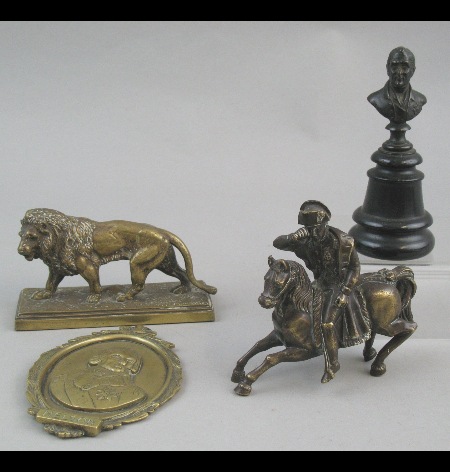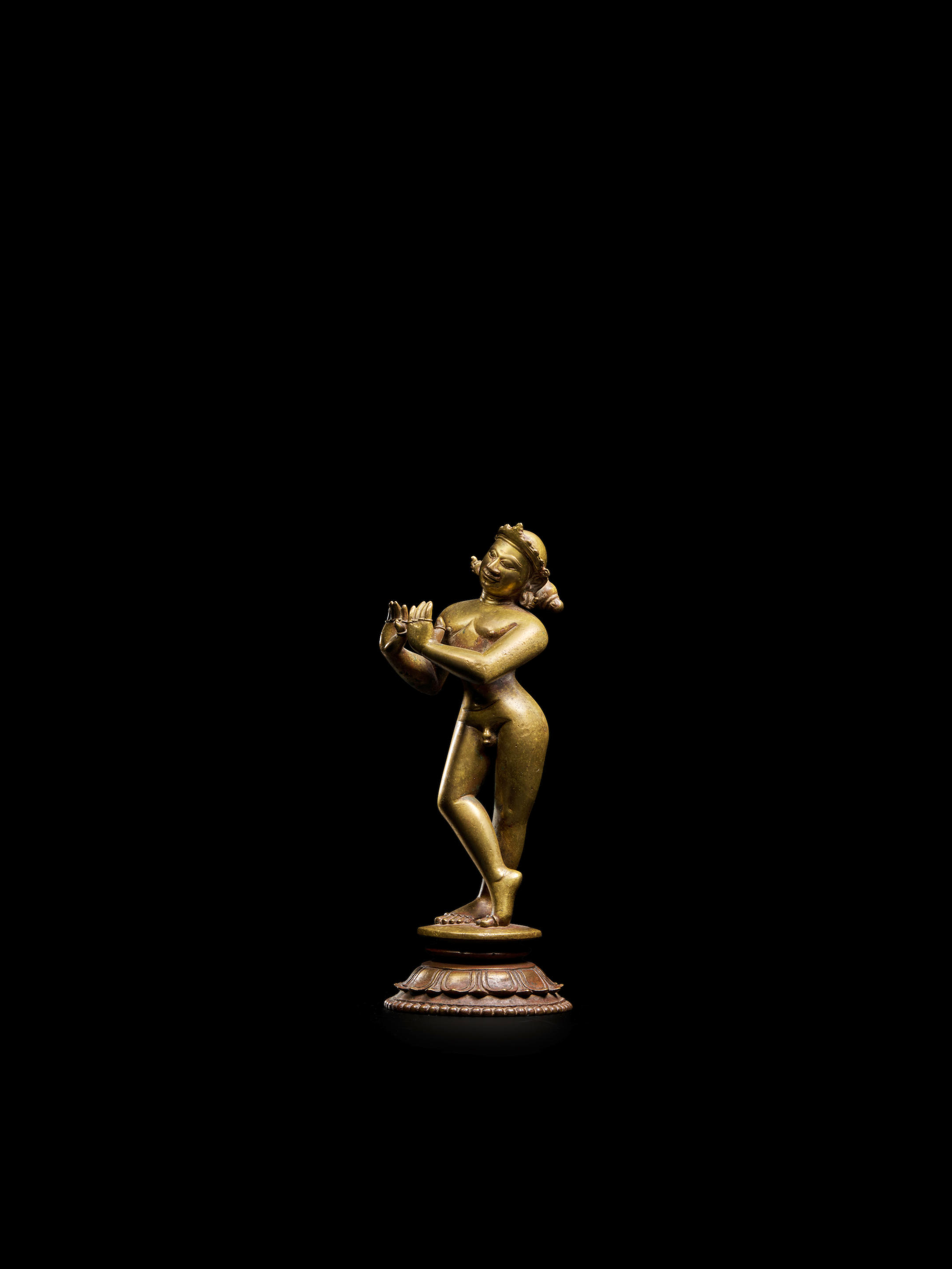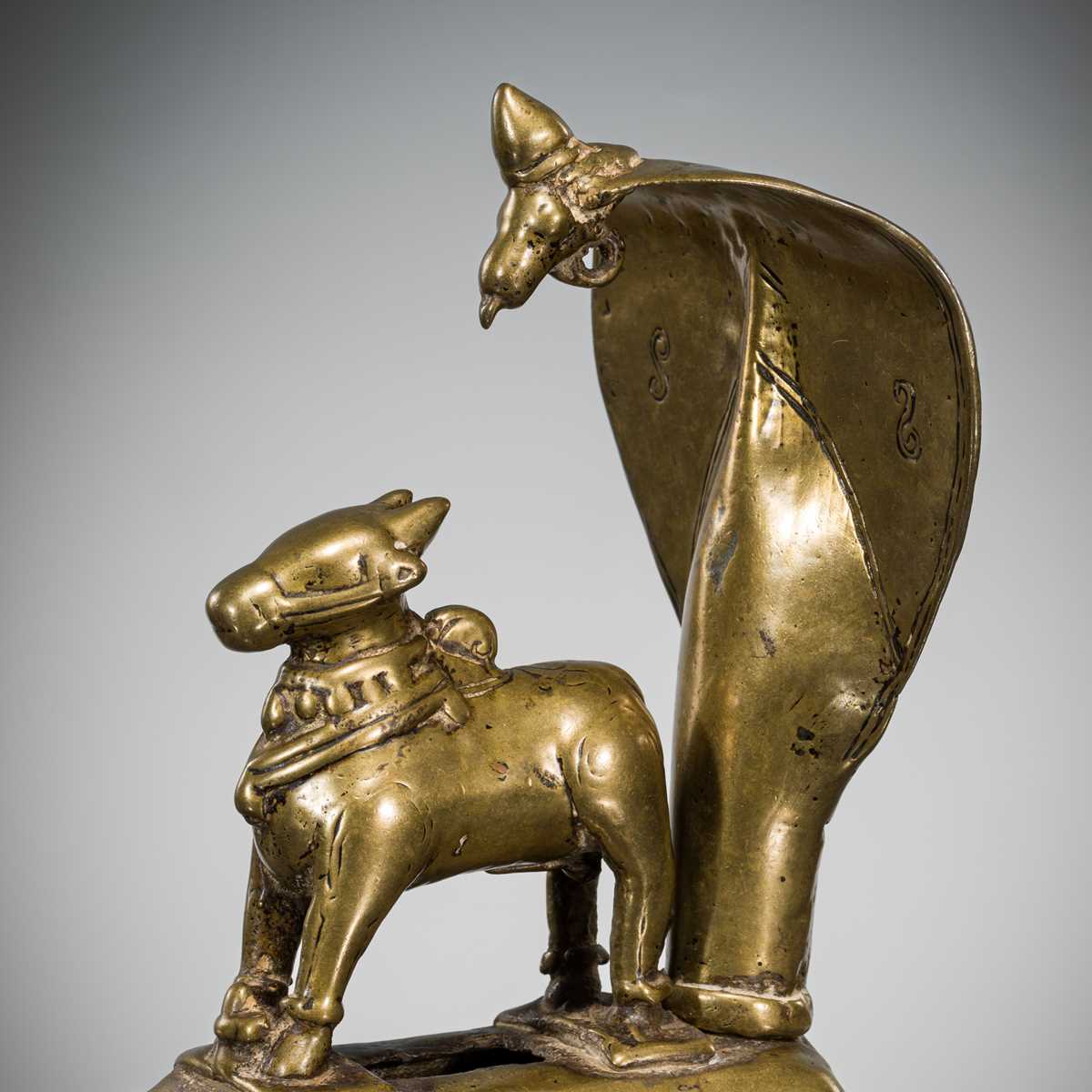A BRASS FIGURE OF VAIKUNTHA VISHNUKASHMIR, 8TH/9TH CENTURY Bearing a three-line inscription on the back of the pedestal. Himalayan Art Resources item no.4535 7 1/2 in. (19 cm) highFootnotes克什米爾 八/九世紀 毗濕奴銅像 With its raised details worn smooth by centuries of worship, this bronze survives with the desirable, glossy patina of a much-cherished icon. Its subject – Vishnu in a cosmic manifestation as Vaikuntha – is iconic and easily recognizable. The name Vaikuntha was first mentioned in the 7th-century Vishnudharmottarapurana, where Vishnu is described as manifesting in the form of a four-headed god, with a peaceful human face in front, a lion and a boar's face on the two sides, and a ferocious face at the back. Here the lion and boar are vividly depicted with their mouths agape, representing Vishnu's Varaha and Narasimha avatars. He stands with his left foot slightly in front of his right, holds a lotus flower and a conch shell in his upper hands, and rests his lower hands on the heads of two diminutive figures – Gadadevi, the female personification of his battle mace, and Chakrapurusha, the male personification of his war discus. Enlivening the composition, a tiny effigy of the Earth goddess, Prithvi, emerges from the base between Vishnu's feet, while another female figure, likely representing the donor, quietly sits by the left side of the pedestal. Vaikuntha Vishnu was extremely popular in Kashmir during the 8th to 10th centuries. Numerous sculptures of the same subject, both in metal and stone, have survived from the period. The present work is closely related to two other Vaikuntha sculptures from the same period—one formerly in the Nasli and Alice Heeramaneck Collection and currently preserved at the Los Angeles County Museum of Art (M.80.6.2), and the other previously in the John D. Rockefeller III Collection and currently in the Asia Society Museum, New York (1979.43). Both examples are larger than the present work, but share the same composition, figural type, and pedestal design. All three gods are afforded a youthful body, with cruciform navel and slightly exaggerated musculature around the abdomen. They also wear similar crowns, necklaces, and armbands, as well as a long and prominent flower garland looping in front of their legs. All three pedestals are designed with a spout extending from the right upper edge, for draining off any fluids being poured over the figures during worship. The LACMA example also features a donor figure by the left side of the base. The current bronze compares favourably to a smaller 8th-century Kashmiri Vaikuntha in the Victoria and Albert Museum, London (IM.9-1937). Also see contemporaneous stone sculptures of the same subject in the Metropolitan Museum of Art, New York (1991.301) and LACMA (M.69.13.2). Provenance: Christie's, New York, 3 October 1990, lot 189 Private European Collection
A BRASS FIGURE OF VAIKUNTHA VISHNUKASHMIR, 8TH/9TH CENTURY Bearing a three-line inscription on the back of the pedestal. Himalayan Art Resources item no.4535 7 1/2 in. (19 cm) highFootnotes克什米爾 八/九世紀 毗濕奴銅像 With its raised details worn smooth by centuries of worship, this bronze survives with the desirable, glossy patina of a much-cherished icon. Its subject – Vishnu in a cosmic manifestation as Vaikuntha – is iconic and easily recognizable. The name Vaikuntha was first mentioned in the 7th-century Vishnudharmottarapurana, where Vishnu is described as manifesting in the form of a four-headed god, with a peaceful human face in front, a lion and a boar's face on the two sides, and a ferocious face at the back. Here the lion and boar are vividly depicted with their mouths agape, representing Vishnu's Varaha and Narasimha avatars. He stands with his left foot slightly in front of his right, holds a lotus flower and a conch shell in his upper hands, and rests his lower hands on the heads of two diminutive figures – Gadadevi, the female personification of his battle mace, and Chakrapurusha, the male personification of his war discus. Enlivening the composition, a tiny effigy of the Earth goddess, Prithvi, emerges from the base between Vishnu's feet, while another female figure, likely representing the donor, quietly sits by the left side of the pedestal. Vaikuntha Vishnu was extremely popular in Kashmir during the 8th to 10th centuries. Numerous sculptures of the same subject, both in metal and stone, have survived from the period. The present work is closely related to two other Vaikuntha sculptures from the same period—one formerly in the Nasli and Alice Heeramaneck Collection and currently preserved at the Los Angeles County Museum of Art (M.80.6.2), and the other previously in the John D. Rockefeller III Collection and currently in the Asia Society Museum, New York (1979.43). Both examples are larger than the present work, but share the same composition, figural type, and pedestal design. All three gods are afforded a youthful body, with cruciform navel and slightly exaggerated musculature around the abdomen. They also wear similar crowns, necklaces, and armbands, as well as a long and prominent flower garland looping in front of their legs. All three pedestals are designed with a spout extending from the right upper edge, for draining off any fluids being poured over the figures during worship. The LACMA example also features a donor figure by the left side of the base. The current bronze compares favourably to a smaller 8th-century Kashmiri Vaikuntha in the Victoria and Albert Museum, London (IM.9-1937). Also see contemporaneous stone sculptures of the same subject in the Metropolitan Museum of Art, New York (1991.301) and LACMA (M.69.13.2). Provenance: Christie's, New York, 3 October 1990, lot 189 Private European Collection















Testen Sie LotSearch und seine Premium-Features 7 Tage - ohne Kosten!
Lassen Sie sich automatisch über neue Objekte in kommenden Auktionen benachrichtigen.
Suchauftrag anlegen